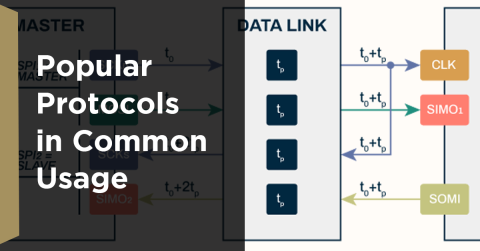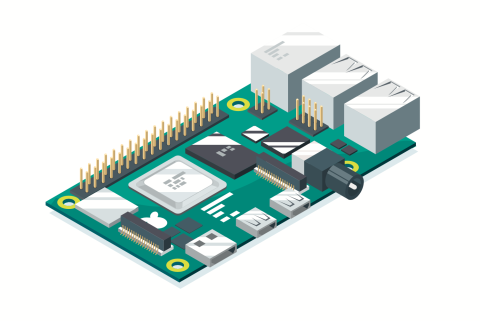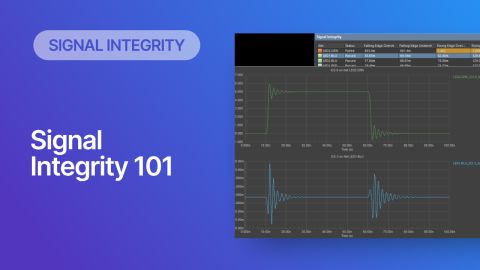Transmission Line Transfer Function from ABCD and S-parameters

Circuit designers and board designers like to use S-parameters to describe signal behavior as it passes through an interconnect. These important parameters tend to get overgeneralized (in my opinion), and there are other important quantities that may be easier to calculate if you use some different parameters. In particular, a transmission line transfer function is one important quantity used for signal integrity calculations and simulations, particularly when modeling an interconnect in lossy media.
A transmission line transfer function also allows you to simulate signal behavior for any input stimulus using an impulse response function, which is a critical aspect of high speed signal integrity simulations and modeling for modern signaling standards. The power of this method seems to be lost on many PCB engineers and has become the purview of IC engineers. PCB designers often default to simulation tools to examine this aspect of interconnect design, which inevitably produce the wrong results because they aren’t accounting for all high speed effects in a real channel.
Despite these drawbacks, there are some simple calculations you can perform to get an accurate view of how a signal will behave on real transmission lines with real load components and termination. Let’s look at a simple yet powerful way you can calculate the transfer function of your transmission lines and learn more about your system.
Transmission Line Transfer Function Equations
By far, the easiest way to calculate a transmission line transfer function is to use ABCD parameters or S-parameters. I prefer to use ABCD parameters because I work on modeling, and they are more easily generalized to any transmission line. After all, they are defined directly from the general solution for a transmission line. I personally think S-parameters get over-generalized and are misapplied to situations where they don’t fit so well conceptually. I think it’s also important to note that there are other equations for converting between different types of parameters (e.g., Z-parameters, Y-parameters, etc.), so you can always find a way to get to the transfer function.
If you’re unsure of why we need to get to a transfer function for a transmission line, I’ll go over it at the end of the article. For now, just know that regardless of which approach you want to take, ABCD parameters and S-parameters offer some specific advantages:
- Why use ABCD parameters: These parameters are defined directly from the general solution for any transmission line (as long as it’s an LTI system). They are far more generalizable than S-parameters, including to cases with copper roughness, causal dispersion, and fiber weave/skin effect losses. ABCD parameters are best for cascaded networks (e.g., line + stub + line + load branch type networks) as you can just multiple ABCD matrices together.
- Why use S-parameters: These are what you would normally measure in a standard setup for characterizing high-speed channels with multi-GHz bandwidths. Therefore, it’s natural to use these to calculate a transfer function as you don’t need to do some other complicated inversion from impedances. Both sets of parameters can be generalized to N-port networks, but ABCD parameters require building a transfer function matrix, while S-parameters are easy to extend to N ports.
If you can accept the above arguments for using ABCD parameters on the theoretical side and sticking with S-parameters on the experimental side, then we’re ready to jump into the important equations you’ll need.
From ABCD Parameters
The standard definition of the ABCD parameters is shown below. These equations apply to any transmission line as long as you know its impedance and propagation constant:
The Z0 term in the ABCD parameter equation is the transmission line's characteristic impedance.
Note that the ABCD matrix, which is invertible, is defined “backwards” in that it relates the input voltage/current (i.e., looking towards the load) to the output voltage/current. This is okay; to create a relation that shows the output voltage/current as a function of input voltage/current, simply calculate the inverse matrix. You don’t need to do this to find the transfer function for a transmission line.
The voltages (V1 and V2) and the currents (I1 and I2) are defined in terms of the circuit diagram shown below. In this circuit diagram, we have a source voltage (VS) that is built into the IC, which the IC is attempting to source into the transmission line. The driver also has a source impedance of ZS. Due to the source impedance and trace impedance, VS is divided across these values to produce V1 which is the voltage that could be measured from the output pin. The output voltage on the transmission line is V2, which is fully dropped across the load (VL = V2).
The goal of defining a transfer function is to calculate the ratio between the voltage we are attempting to source (VS) and the voltage we measure at the load (VL). You can use the ABCD parameters defined above with the following formula to get the transmission line transfer function:

This is defined in terms of frequency, or in terms of the Laplace domain if we want to predict transient response.
One point to stress in this discussion is that the transfer function and the above equations for the ABCD parameters do not rely on a reference impedance. The ZS and ZL terms in the above transfer function equation arise because we are considering that this circuit is actually connected to a specific source impedance (ZS) built into the driver, and there is a known load impedance (ZL). The reference impedance becomes important when looking at S-parameter measurements because VNAs rely on a reference impedance to interpret measurements from propagating waves.
From S-Parameters
The other approach to this problem is to use S-parameters. As I mentioned above, this is great if you have some measurements of your channel’s S-parameters and you want to get the transfer function by assuming ZS = ZL = reference impedance. In this case, your S-parameters are referenced to a specific impedance Z at both ports, and you can just use a simple S-parameter to ABCD parameter conversion:

After converting, just plug these into the transfer function equation shown above, and you’re finished. Remember, Z in this equation is the reference impedance, which is usually taken as the load or characteristic impedance of the line.
Alternatively, you may want to calculate the S-parameters directly from ABCD parameters in the event you don’t have any S-parameter measurements. The formula below shows S-parameters defined from ABCD parameters assuming both ports have the same reference impedance. You can then use these to calculate a transmission line transfer function. Again, watch out for the reference impedance in the following formula:

The above equation would be used to predict what would be observed in a measurement with a specific reference impedance (Z), such as with a VNA.
If we have different port impedances, such as a specific source impedance Z01 = ZS and a load impedance Z02 = ZL, we have the S-parameters defined as:

Finally, with either of the above equations, we can calculate the transfer function using the S-parameters and the reflection coefficients at the source and load (ports 1 and 2, respectively):

Standard Transmission Line Transfer Functions
There are some "standard" transmission line transfer functions that apply to arbitrary load impedances, including capacitive inputs on integrated circuits or more general loads that include package/pin inductance. The standard transmission line transfer functions outlined below are defined for loads with capacitive inputs (both terminated and unterminated), which is a typical model used to quantify the load capacitance on the input of a digital integrated circuit.
In all of the transmission line transfer functions shown below, the above formula has been used with ABCD parameters. The difference between the results for each model is the definition of the load impedance. These examples are typically found in literature on integrated circuit design and layout, but they influence signal beahavior on the PCB as well.
Capacitive Loads
The simplest way to understand the input of an integrated circuit is with its load capacitance. There are three cases that must be considered with a simple capacitive input, as shown below. The following cases produce a channel impulse response that obeys the standard knee frequency formula:
- Length = 0 transmission lines with ZS = 0
- Purely lossless transmission lines with ZS = Z0
- Purely lossless transmission lines with ZS = 0 and Length -> infinity
These three cases are all valid for the circuit model shown below. These cases apply to fast single-ended I/Os, mainly GPIOs and SPI/QSPI buses on fast digital ICs.
If we have Re(gamma) = 0 (no losses in the channel) or channel length = 0, then we would find that f(knee) = 0.35/(rise time). This is the knee frequency definition, which despite its apparent universality, is not a measure of actual signal bandwidth.
The next case concerns capacitive loads terminated at a specific resistance at the load. In effect, this creates a nearly perfectly-matched load at low frequencies with low-pass filter behavior at high frequencies. The high-frequency characteristics are determined by the load capacitance; beyond some cutoff, the bandwidth will start to roll off. In addition, the knee frequency relation may no longer hold due to the combined effects of the load capacitance and the losses along the transmission line.

Capacitive Input With Package Inductance
Another model that applies in more advanced packages, such as heterogeneously integrated packages on a substrate/interposer/redistribution layer. In these packages, the received signal has to travel over a long trace in the package before reaching a bump on a die, and this interconnect has some inductance. Package inductance also applies at the other end of the advancement spectrum, where the inductance is provided by a bond wire between a pin and the semiconductor die. In either case, the typical model shown below will apply.

To use the above model, just plug in the function for ZL and ZS; I'll leave this as an exercise for readers. If we added a series resistor onto the source's output pin, we would have to swap ZS --> ZS + R.
The model shown above provides a general idea; real load models in advanced packages can be a more complex variation of this example. The filtering action of the load impedance here is 2nd order and the transfer function is much more complex, containing complex poles and zeros. However, as long as you can derive the load impedance, then you can use the transfer function definition above to write out the transfer function for the combined transmission line + load.
The above examples are derived assuming single-ended channels, but a similar idea applies to a differential channel as long as there is no DC offset on the signal and no split termination on the receiver input. Real differential receivers are more complex and will use split termination, possibly with DC pull-up bias. To learn more about these terminations for differential interfaces, read this article.
Finally, to learn more about all of the cases above, watch this video on transmission line transfer functions. It shows the various cases of terminations outlined above and runs through the assumptions presented in each.
Other Transfer Functions
Note that an S-parameter itself is a transfer function, but not in the sense that it provides a conceptually useful impulse response. The same can be said for Z-parameters and Y-parameters, which don’t have conceptually satisfying meanings. This is why a transfer function (in the sense of filters and amplifiers) is normally used for high speed channel characterization; its impulse response function does have a concrete meaning in a channel or circuit.
Once you’ve calculated the transfer function, remember that it is bandlimited, so you will need to apply a windowing function before you can calculate the channel’s response. Numerically, I think it’s easiest to just get the channel’s response using the inverse Fourier transform and the windowed transfer function H(f):
The above definition is given in terms of Fourier transforms, but it also applies for Laplace transforms. In general, when you are working with non-periodic impulses in a linear system with complex poles, the Laplace transform definition is preferred. Alternatively, you can calculate the channel’s response using the convolution theorem, i.e., with the channel’s impulse response function. This now tells you how the channel will respond when excited with an arbitrary stimulus.
Once you’ve found the transmission line transfer function and you’re ready to layout your channel, use the design and layout tools in Altium. You’ll have the routing and /layout features you need to route transmission lines and waveguide geometries with ease. Altium delivers an unprecedented amount of integration to the electronics industry until now relegated to the world of software development, allowing designers to work from home and reach unprecedented levels of efficiency.











